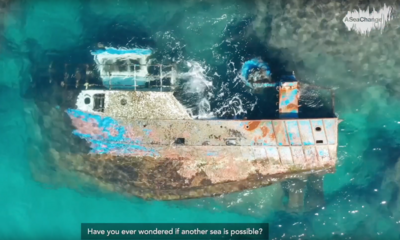A sea change, rethinking the Mediterranean
7. März bis 30. April 2024 Barcelona, Spanien
A sea on edge presents a series of works that epitomize the interdisciplinary research collaboration that has been taking place in the two years of duration of the international project A Sea Change. A project that blended art, science, and environmental advocacy to dissect the complexities of the Mediterranean’s Blue Economy, whilst seeking to cultivate critical perspectives on how we connect and engage with this vital marine biome.
Drawing inspiration from the American marine biologist and writer Rachel Carson (The Edge of the Sea, 1955), this exhibition aims to develop thoughtful and critical perspectives on the way we interact with the sea and use its resources for economic growth. It seeks to actively participate in discussions encompassing ecological, political, aesthetic, ethical, and scientific aspects, all centered on envisioning the future of the Mediterranean.
A unique transgeographic body of water with a coastline spanning across 22 countries, this “sea enclosed by land”, is not only rich in history and biodiversity, but also carries immense economic and geopolitical significance. Nevertheless, it is now confronting extraordinary challenges that jeopardize its fragile equilibrium and the livelihoods of countless individuals who rely on it.
A hub for cultural and economic activity, supporting over 150 million people living along its coastline, the Mediterranean endures multiple anthropogenic actions, and is undergoing intensive demographic, social, cultural, economic and environmental changes. The sea is changing due to enduring a myriad of human pressures. These include overfishing, cargo shipping (which carries 90% of the goods we consume), mass tourism (accounting for one-third of the world’s total), deep-sea mining, and the installation of underwater telecommunications cables, among others. This array of activities leads to the weakening of the sea, making it vulnerable to pollution, biodiversity loss, seabed damage, the spread of non-indigenous species, marine litter, underwater noise, and the effects of ocean warming and acidification.
Our Mare Nostrum is on edge, warming 20% faster than the global average and experiencing increasingly frequent droughts, which is why we must envision alternatives to sustain and strengthen our ancestral connection with this rapidly changing sea.
And so, if the sea is on edge perhaps it is time to encourage hope in order to act and repair this vital ocean river. This requires not only reversing current abusive dynamics, but also recognising and managing the seas as a collective resource whose protection and conservation is equally incumbent upon us all. Perhaps the only prospect of well-being for everyone is to manage the seas by applying common principles and encouraging local communities to do the same. We should aspire to cultivate a future where innovative, sustainable practices infuse new life into these waters, revitalizing their essence and safeguarding the ancient ties that link us to this ever-evolving sea.
How much is the sea worth?
quoartis.org/project/a-sea-change
a-sea-change.net
www.youtube.com
